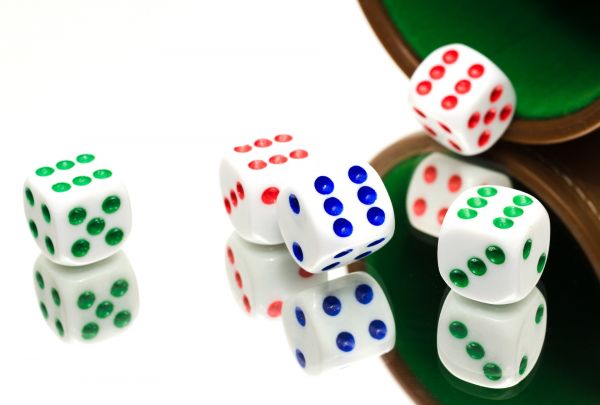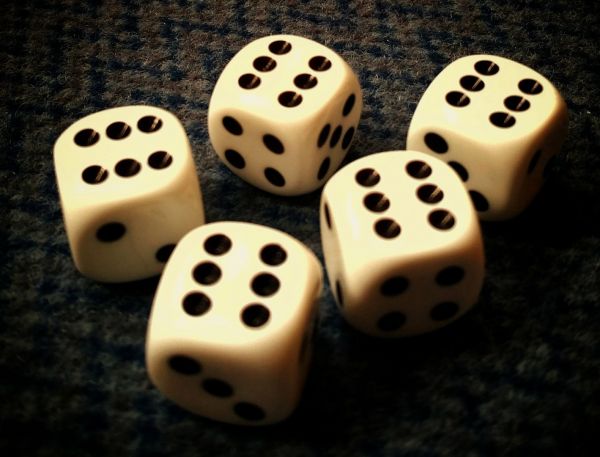Yahtzee Strategies: Giving Yourself a Fighting Chance

All games have an element of chance to them. Your path to victory or defeat always depends to some extent on the moves of your opponent, after all. But some games are more reliant on chance than others. With a game like Yahtzee, the goal is to minimize chance’s influence on the outcome, and that’s what I’m here to get you thinking about.
One guiding principle of this strategy is that each game actually presents three Chances, not one. Usually, the first one you want to consider is the Aces box. Yes, you’ll need to collect four of another number to earn your Upper Bonus if you deplete your Aces—assuming you claim three of everything else in the Upper Section—but you’re never down by more than three points, even if you zero out. Next, consider the official Chance slot. I always hope to score at least 20 on Chance, but that’s not a hard-and-fast rule. Desperate times call for desperate measures. Okay, so you’ve probably considered these two options in similar terms at one time or another, but what’s the third Chance? The 3 of a Kind. Why? Its frequency is the highest of anything in the Lower Section, except for Chance. That means I don’t use it until I need to. Some people apply this logic to the Full House, but I seldom finish a game without putting something in the 3 of a Kind box. Not so with the Full House.
This brings me to my next question: should you claim a Full House if you accidentally shake one in the early rolls of a game? The answer is yes, if the Full House is made up of low numbers. It’s a reasonable move if you acknowledge that you have three Chances, should you run into trouble, and not just one. On the other hand, if I roll a Full House on my first shake and it’s made up of three Sixes and two Threes, I’m re-shaking those Threes. Probably even if it consists of two Sixes and three Threes.
Your strategic approach should always include dividing your attention more or less evenly between the Upper Section and the Lower Section, by the way. It’s a good habit because the harder you try to force the completion of one section before moving to the other, the more you invite the unwanted elements of long odds and bad luck. A three-Chances view of the game can help you avoid this.
Along similar lines, you might wonder if you’re better off using a group of three matching dice for 3 of a Kind or for the Upper Section. If I end my first turn with three Sixes, a Two, and a Four, I’ll probably go with 18 for my sixes. Again, Aces, 3 of a Kind, and Chance are safety nets and should be saved for emergency use, but their order of importance is constantly shifting. Let’s assume that Aces are usually your first line of defense. Additionally, let’s say you score 18 with Sixes on your first turn and end up with three Sixes again at the end of your next turn. The 3 of a Kind is the only sensible option, which still leaves you with Aces and Chance as safety nets. Be flexible in your philosophies, in other words.
I use two helpful rules of thumb to tie many of these concepts together as I play: the Gift Horse and the Bird in the Hand. I would advise you to think long and hard before looking a gift horse in the mouth. Once again, let’s use the Full House as our example. If you roll one right out of the cup, there’s good reason to claim it: you may not see another one for the rest of the game. But again, it does depend on the value of the dice. A corollary to the Gift Horse rule is that a bird in the hand is worth two in the bush. If you have four Twos on the table after two shakes, and your Twos are already filled in, the dice are guiding you toward a YAHTZEE, not a Large Straight. It’s usually good to follow that impulse. And if the YAHTZEE doesn’t come, I’m not proud. I’ll use those Twos for my 4 of a Kind, especially if my Aces and Chance have already been used. The Bird in the Hand rule has many applications.
A quick word on re-shaking all five dice during a turn, which you might be tempted to do in the above four-Twos scenario, especially if you already have your YAHTZEE. I advise against this. You lose too much probability and control with one less roll at your disposal. It may prove useful in rare cases, but the three-Chances approach to Yahtzee will help you avoid this undesirable option.

By this time, you may also be wondering about those pesky Straights. Unless I still need my Small Straight, I don’t like to go for the Large Straight too early in the game. Once you’ve nailed the Small Straight—which almost always happens before you nail the Large—it gets riskier to go for the Large Straight; however, waiting or aiming for a Two-Three-Four-Five grouping minimizes this risk, as either an Ace or a Six will complete the coveted Large Straight, which I view similarly to how I view the YAHTZEE; I’ll only go for it so many times before cutting my losses and zeroing it out.
Despite all of this, it’s important not to get so caught up in strategy that you forget to incorporate simple math into your game. If a 3 of a Kind scores considerably higher than using the roll for your Upper Section, it might be worth taking advantage of, especially if the scores are close, the game is coming to an end, and it doesn't appear likely that you’ll get your Upper Bonus anyway.
Another potential problem with strategy is that misconceptions abound. For instance, it is common to take into account how well, or poorly, one’s opponent is playing. But what does that really mean? Should you increase or decrease the risk of your decisions? Such thinking is a distracting rabbit hole and should be avoided at all costs. Concentrate instead on playing the best game you can play with the dice that you roll, every time. Chances are you won’t sit down for just one game anyway, right? Maybe your prize is the best out of three, not any single game. This doesn’t mean that you shouldn’t pay attention to your opponent’s moves, however. Individual outcomes on her side may tip the scales and cause you to favor one otherwise equal option over another.
It's also important to keep an aerial view of the game’s logic as you consider the above details. Think of the Upper Half as being broken into three groups: Aces and Twos; Threes and Fours; and Fives and Sixes. Group Three is your highest priority, followed by Group Two and then Group One. A compelling reason for viewing the Upper Section in this way is that getting four Fives or four Sixes creates a stronger buffer for the Upper Bonus than getting four of a Group Two number, and so on down the line. That Upper Bonus, by the way, is high priority in every game, so factor it in to whatever strategy you adopt. Just remain somewhat loose about it. If you have two Twos and one Four on the table, with one shake left, and you still need to fill both of those boxes in your Upper Section, the Twos are a better gamble.
But say you’re left with nothing useful at the end of a turn. It happens to us all from time to time. Here’s where the three-Chances view can really save the day. If your Aces or Chance are still open, pick one (only zero out your 3 of a Kind as a last resort). Otherwise claim the lowest die on the table that you still need. It may alter your plans for the game, but it's always best to proceed with a road map in mind, even if it changes from roll to roll. This may also be the time to zero something out and readjust your end-game strategy accordingly.
Not all of this information is meant to stick after one reading, but I hope that enough of these ideas will be running through your mind the next time you play a game of Yahtzee that you’ll start to build on them through trial and error. It takes time to develop a feel for when your game is going south because of bad plays versus rotten luck, and you’ll still lose plenty of matches no matter what. But over time, your track record will improve if you follow the above advice.
Now get out there and roll them bones.
And of course … good luck!




